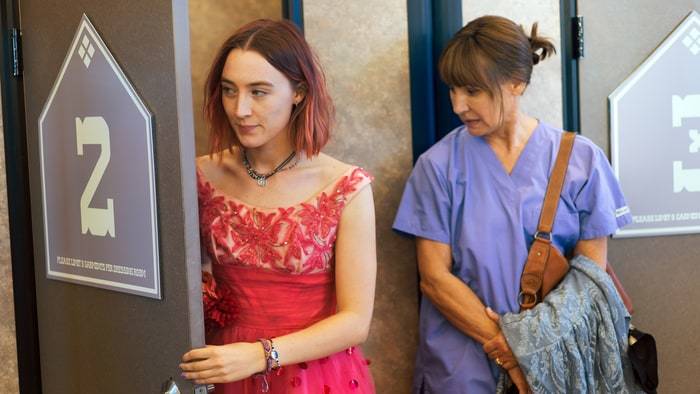
“Lady Bird” stars “Brooklyn’s” Saoirse Ronan as high school senior in 2008, with Laurie Metcalf and Tracy Letts as her parents. Writer/director Greta Gerwig tells the story in pointillist fashion, small incidents along the way illuminating the jubilant dreams, crushing fears, and struggles with parents, friends, and teachers she must navigate as she gets ready to leave home. Her name is Christine, but at an audition for the high school play, she explains that “Lady Bird” is her given name — because she gave it to herself. In an interview, Gerwig talked about the influence of John Hughes films like Pretty in Pink and finding the music in the dialogue.
You must be thrilled with the enthusiastic reception you’ve been getting from festival audiences.
Everybody’s got a family, everybody’s got a hometown, everybody understands leaving home. It feels like it’s the thing that people can connect to from their hearts which is always my goal and I’m so pleased that people feel that way.
You’ve spoken before about the importance of conveying female friendships and Lady Bird learns some painful lessons about friendship in the film.
I’m always interested in relationships between women. I’m always interested in how women relate to each other, whether it’s a family relationship or it’s a friend relationship. That’s such uncharted territory in cinema. Usually women don't have any relationship with each other; they just have relationships with the male protagonists. That's something both that I'm interested in and it’s also something that I’ve taken on quite deliberately in the work that I’ve co-written and now with this movie.
Were the John Hughes movies about teenagers an influence for you?
I was a big fan of John Hughes movies, particularly Pretty in Pink, but they have embedded within them generally an idea of one guy which I philosophically disagree with. I started from the premise of, “What if there were two guys and they are both wrong?” I wanted to honor what’s so wonderful about those films while not actually doing the film. With her romances, I wanted both the satisfaction of the vividness of teenage emotion and falling in love and giving the audience that point of connection, but then also the film knows that that’s not the end all and be all, that the movie that’s playing in her head is different than the movie that she’s in which I think is often true in life. Teenagers are living out some romantic ideal and the reality is that no one’s doing it with them.
Christine wears a uniform because she goes to parochial school, but her look is still very distinctive.
I worked with a great true artist, the costume designer April Napier. She is a real storyteller and that's what I look for in all my department heads and really everyone who works on the movie. She has the ability to bring me costumes or pieces that totally surprised me and were totally unexpected but they were exactly right. The pink prom dress that Christine finds in a thrift shop was a little tip of the hat for Pretty in Pink.
The parents in the film are beautifully portrayed and they have their own real characters and storylines.
I wanted it to ultimately be really the mother's story as much as it was the daughter's story because one person's coming of age is another person's letting go. Even if Laurie says the wrong thing or Saoirse is being a jerk you don't feel like ultimately that’s who either of them are. You just feel like they're struggling through this difficult time. The time itself is relentless which adds to the anxiety.
You've worked with quite a range of directors as an actress. What kinds of ideas did you take from the way they approach the material that helped you in your first time as a solo director?
One of the great advantages of my time spent in movies and in basically every role possible both in front of the camera and behind the camera that I’ve gotten to see all these different ways that people work and the way movies are constructed from the inside out, from beginning to end. Because I didn't go to film school this was really my training; everything from tiny things to big things.
From Mike Mills I took the idea that everyone on the crew who is not an actor, including me, wears a nametag every day. It sounds small but it’s actually huge because as a director you're with your crew the whole day but actors are really only brought in when the scene is completely lit and ready to go and they don't have as much of an opportunity to really get to know all the gaffers or grips or the boom operator and sometimes those people switch out. Being able to call them by their names instead of just “hey you” is a big deal. From Rebecca Miller I took the idea that the director needs to arrive every day an hour ahead of everyone else and walk through the entire day. They have to be over-prepared so that the actors feel like they have all the time in the world and there is never a feeling that the director is time stressed. From Noah Baumbach I learned to have a strict no cell phone policy on set. There is nothing that bums you out more than looking over and seeing somebody on their smartphone and that goes for actors and everyone else. Everybody told me, “Oh, good luck, you have so many kids in this movie. How are they ever going to not text?” The truth is they all left their phones in the trailer and I just felt like it made everybody so much more present.
